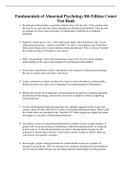Exam (elaborations)
Test Bank for Fundamentals of Abnormal Psychology 8th Edition Comer Chapter 1 - 16 Updated 2023
- Course
- Institution
- Book
Fundamentals of Abnormal Psychology 8th Edition Comer Test Bank Test Bank for Fundamentals of Abnormal Psychology 8th Edition Comer Chapter 1 - 16 Updated 2023
[Show more]




